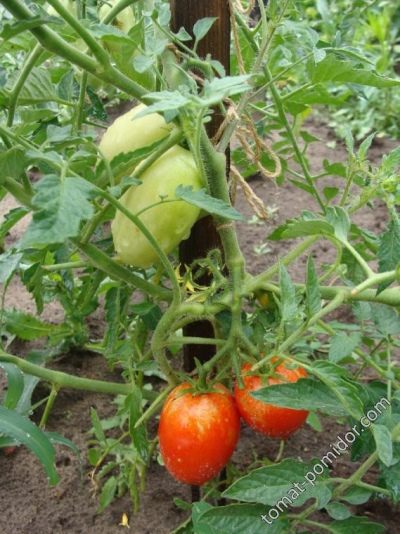
- Authors: Kashnova E.V., Antipova N.Yu., Andreeva N.N., Stolbova T.M., Kotelnikova M.A.
- Year of approval: 2007
- Category: grade
- Growth type: determinant
- Appointment: fresh consumption, for pickling and preserving
- Ripening period: mid-season
- Growing conditions: for open ground
- Bush height, cm: 80-100
- Leaves: large, green
- Unripe fruit color: light green
Tomatoes, bred in 2000, are gradually becoming part of the gold selection fund. And the Garden Sorcerer has every chance of getting into this particular category of cultures. However, even such an attractive plant gives good results only on condition of impeccable knowledge of its features.
Breeding history
The advantage of culture is the fact that it is a variety in the narrow sense of the word, and not a hybrid. The tomato was officially approved for use in 2007. The work on the project was carried out by such specialists as:
Kashnova;
Antipova;
Stolbova;
Andreeva;
Kotelnikov.
Description of the variety
The bushes of the Garden Sorcerer develop according to a determinant pattern. The official description indicates that this plant is optimal for outdoor use. The height of the tomatoes varies from 0.8 to 1 m. Their large foliage has a simple green color.
The main qualities of the fruit
At an early stage of development, when the berry is just laid out of the ovary, a light green color is typical for it. When fully ripe, the crop acquires the usual red color for most tomatoes. Weight varies from 52 to 150 g. Other nuances are as follows:
the shape of tomatoes is usually cylinder-like;
their development comes from simple inflorescences;
the peduncle is articulated.
Taste characteristics
The smooth peel of tomatoes does not have any significant effect on their taste perception. The flesh inside the fruit will invariably be firm. This tomato is sweet to taste, it does not differ much from classical plants of the same type. There is a rather noticeable sour note, but it does not leave an unpleasant impression.
Ripening and fruiting
The variety Garden sorcerer belongs to the mid-season category. It is characterized by high resistance to weather changes. Typically, 90 days elapse between transshipment into the ground and the readiness of the crop for harvest. But in a number of cases, meteorological conditions and peculiarities of agricultural technology can correct this indicator.
Yield
The fertility of the Garden Sorcerer is not overwhelming. It is declared at the level of 3.5 kg per 1 sq. m. However, this is a completely stable result. Importantly, it is achieved only through optimal agricultural technology.
The timing of planting seedlings and planting in the ground
Sowing seeds in seed containers is advised in March. Then, usually, readiness for planting in open ground is achieved at the age of 60-65 days. But you need to look not only at the calendar, but also at how exactly the seedlings are developing. It is worth thinking about the degree of heating of the soil, of course.

Growing tomato seedlings is an extremely important process, because it largely depends on whether the gardener can harvest at all. All aspects must be taken into account, from seedbed preparation to planting in the ground.
Landing scheme
The most commonly used system is 40x40 cm. This is the option recommended by the supplier of planting material. Trying to find another solution is unlikely to be successful.

Growing and care
The garden sorcerer does not require pinching under normal conditions. However, such a procedure is still sometimes carried out if the bushes are very much neglected. But tying to a support and giving the plant a certain shape will be a must. In open gardens, it is recommended to form plantings of this variety in 1-2 stems. If it is grown in a closed greenhouse, then it is required to choose a management scheme of 3-4 stems.
The cultivation of the Garden Sorcerer in an open garden is recommended for the southern regions. In northern areas and in areas with an unstable climate, it is advisable to plant it in greenhouses. The picking of seedlings is made provided that it has at least 2 true leaves. Water the plantings with either a limited amount of water daily, or abundantly every week. Young shoots are fed with diluted manure and other organic matter, adult plants - mainly with mineral compounds.
To avoid infection, Bordeaux mixture is often used. An alternative to it would be other fungicides, including copper. Regular spraying takes place at the end of July and August. The garden sorcerer is not very susceptible to verticillium and fruit rot. However, it is worth remembering about such a dangerous ailment as a black leg - a cure for it is impossible; the affected bushes will have to be burned, and the site will have to be treated with special preparations.




A plant needs different micronutrients at each stage of growth. All fertilizers can be divided into two groups: mineral and organic. Folk remedies are often used: iodine, yeast, bird droppings, eggshells.
It is important to observe the rate and period of feeding. This also applies to folk remedies and organic fertilizers.


Growing regions
It is quite possible to plant a Garden Sorcerer and count on a decent harvest in:
The Astrakhan region;
Leningrad region;
Karelia;
Moscow region;
middle lane;
Volga region;
Western Siberia;
Eastern Siberia;
Black earth;
Volga-Vyatka region;
various localities of the Urals and the North Caucasus.
Review overview
According to gardeners, this variety can indeed produce a bountiful harvest. At the same time, it is noted that it is difficult to count on a good result without a garter. The taste and beauty of the fruits with good agricultural technology are provided in equal measure. Cultivation efficiency is equally high in open plantings and in polycarbonate greenhouses. Complaints, if any, are very rare.

























































































